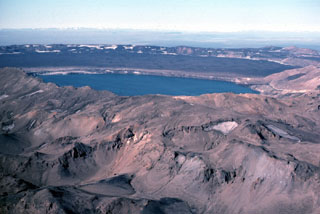Report on Askja (Iceland) — 8 September-14 September 2021
Smithsonian Institution / US Geological Survey
Weekly Volcanic Activity Report, 8 September-14 September 2021
Managing Editor: Sally Sennert.
Please cite this report as:
Global Volcanism Program, 2021. Report on Askja (Iceland) (Sennert, S, ed.). Weekly Volcanic Activity Report, 8 September-14 September 2021. Smithsonian Institution and US Geological Survey.
Askja
Iceland
65.033°N, 16.783°W; summit elev. 1080 m
All times are local (unless otherwise noted)
On 9 September IMO raised the Aviation Color Code for Askja to Yellow, noting that inflation that began in early August was ongoing and notably rapid. The uplift was centered at the W edge of Oskjuvatn caldera, which rose a total of 7 cm. The data suggested that magma was accumulating at 2-3.5 km depth.
Geological Summary. Askja is a large basaltic central volcano that forms the Dyngjufjöll massif. It is truncated by three overlapping calderas, the largest of which is 8 km wide and may have been produced primarily from subglacial ring-fracture eruptions rather than by subsidence. A major rhyolitic explosive eruption from Dyngjufjöll about 10,000 years ago was in part associated with the formation of Askja caldera. Many postglacial eruptions also occurred along the ring-fracture. A major explosive eruption on the SE caldera margin in 1875 was one of Iceland's largest during historical time. It resulted in the formation of a smaller 4.5-km-wide caldera, now filled by Öskjuvatn lake, that truncates the rim of the larger central caldera. The 100-km-long Askja fissure swarm, which includes the Sveinagja graben, is also related to the Askja volcanic system, as are several small shield volcanoes such as Kollatadyngja. Twentieth-century eruptions have produced lava flows from vents located mostly near Öskjuvatn lake.

